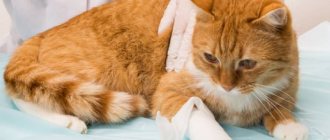If your cat has a swollen ear, it can be caused by a number of different factors. Cats lead an active lifestyle, so they are not immune to injuries, falls from heights, and fights. Insect bites are often the cause of swelling. If the owner notices that a pet's ear is swollen on the outside or inside, it is important to contact a veterinary clinic, since some pathologies can cause serious complications for the entire body.
How to tell if your cat has a swollen ear
It’s not difficult to understand that a cat’s ear is swollen - she herself will give signals that she is not feeling well.
Firstly, the pet will shake its head, scratch its ears, while keeping its head tilted to the side.
Secondly, a swollen ear may become red and inflamed. By the way, you will understand that inflammation is present by a certain putrid smell.
Thirdly , an increase in body temperature can be a clear sign of the presence of swelling in the auricle. As well as a strong increase in the size of the auricle. Sometimes it becomes like a dumpling. A cat will definitely give signals if it is bothered by a sore, swollen ear.
Hematomas of the auricle
A cat's ears are a very sensitive organ.
Hematomas occur when the ear is damaged when blood accumulates in the cavity caused by mechanical force (bite, bruise, prolonged compression). Symptoms:
— When injured, the ear swells, increases in size, and the cat begins to shake its head.
- The bruise is clearly visible.
- The ear cartilage becomes hot to the touch (the local temperature rises).
— A limited soft swelling is detected, the size of which depends on the degree of damage to the blood vessels.
- Fluctuation and pain when feeling the swelling.
— The pet’s general condition, appetite, and physical activity depend on the severity of the damage. With mild hemorrhage, the owner does not notice a decrease in appetite. In severe forms of hematoma, the animal may refuse to eat due to pain and be in a depressed, lethargic state.
Treatment:
1. For small hematomas, cold is indicated in the first hours after injury. Frozen foods from the freezer wrapped in cloth are suitable for this purpose. You can cool the damaged ear for 10 - 15 minutes.
2. If there is an open wound, it is treated with disinfectants. To reduce blood leakage, a pressure bandage is applied to the ear.
3. For extensive hematomas, due to the fact that there is a high risk of infection, the most effective treatment method is surgical.
4. In the treatment of the disease, anti-inflammatory and antibacterial ointments are widely used: levomykolev, synthomycin, chloramphenicol.
5. For suppuration, ichthyol and Vishnevsky ointment are used.
6. Additionally, if the hematoma becomes infected, the animal is prescribed a course of antibacterial therapy. For this purpose, penicillin antibiotics, tetracyclines, and cephalosporins are used.
============================================================================================================================================================================================
Why do cats get swollen ears?
The Murkoshi team has counted several possible reasons why a cat’s ear may become swollen, and is in a hurry to share this information with you.
The first reason is a possible tick bite, or more precisely, inflammation associated with a blood-sucking parasite. After getting rid of the parasite, the swelling will subside on its own within a few days.
Read more about tick bites: How to protect your cat from ticks
The second reason is otitis media, which can also cause swelling in the ear area. But it is very difficult to recognize in the early stages, because it is almost impossible to see minimal inflammation inside the ear.
Read more about this disease: Treatment of otitis media in cats
The third factor is “bruises”, which form a swollen area due to the large volume of blood. By the way, the site of the hematoma will definitely be hot. If there is a hematoma, the cat may shake and scratch its ears. If the “bruises” are not treated, the pet may experience complications in the form of death of the cartilage tissue of the ear.
The fourth possible cause of ear swelling is an abscess that forms after an injury with subsequent suppuration.
The fifth reason is lymphatic extravasation, which also occurs due to injury. But in this case, instead of pus, a bubble filled with lymph and blood is formed. Hence the name of the disease.
The sixth reason is neoplasms in the form of papilloma, fibroma or sarcoma. If there is severe growth in the ear, there is a possibility that the eardrum will close. Which can have a detrimental effect on your pet’s hearing and cause deafness.
Causes of the problem and accompanying symptoms
Otitis in cats
Swelling behind the ear or inside the hearing organ is often caused by this pathology, which can be caused by allergic reactions, fungal, viral or bacterial infections, or traumatic injuries. The inflammatory process is usually divided into three types:
- outer ear;
- internal;
- average
When swelling is observed externally, the superficial tissues are affected, the eardrum is not affected. Middle ear disease is characterized by damage to the membrane. The most dangerous is the inflammatory process in the inner ear. In the process of its development, damage is observed not only to the eardrum, but also to the vestibular apparatus. In addition to the fact that the cat's ear swells, it fills with fluid and there is a discharge of pus. Brain damage is possible. Internal otitis media can cause deafness in your pet.
Inflammation of the inner part of the ear canal makes itself felt by frequent scratching of the auricle by animals.
The following symptoms of the disease are distinguished:
- redness of the skin near the hearing organs;
- pain syndrome due to which the cat constantly scratches its ear;
- decreased activity;
- loss of appetite.
Ear mite
If your cat has a swollen ear, in most situations the problem is caused by a parasite called Otodectes cynotis. A cat can catch it through contact with a sick pet. There are often cases when the owner brings a tick into the house along with dirty shoes. In addition to the fact that swelling appears on the ear, the owner may notice the following symptoms:
- constant meowing;
- brown discharge with a bad odor;
- redness of the skin inside the ears;
- general increase in body temperature;
- pet concern.
Neoplasms
Sarcoma, fibroma and papilloma are often diagnosed in the ear canal. The main danger of these formations lies in the fact that, mainly at the initial stage of development, they do not provoke any symptoms at all. As it progresses, the pet owner may notice the following symptoms:
This pathology makes the animal restless.
- the cat constantly rubs the ear;
- coordination of movements worsens;
- the animal lowers its head towards the affected organ of hearing;
- the pet becomes restless.
Injuries and hematomas
If there is swelling in a cat's ear, it is often caused by traumatic injuries. Hematomas often occur in pets that have free access to the outdoors. Traumatic injuries are characterized by the following signs:
- change in the shape of the auricle;
- increased ear temperature;
- pain syndrome;
- pet aggressiveness.
Abscess in a cat
During the purulent process, the animal experiences thirst.
It often occurs when there is an open wound that has become infected. Often the inflammatory process is accompanied by suppuration, which can have serious consequences for the body. In addition to the fact that the cat’s ear is swollen, the owner may notice the following symptoms:
- loss of appetite;
- weakness;
- thirst;
- redness of the place where the abscess is localized;
- local temperature increase.
How to treat a swollen ear in a kitten
A swollen ear should be treated based on why it is swollen. Therefore, first of all, you need to identify the cause of the swelling, and then begin to eliminate the disease. Only a veterinarian can 100% accurately determine the cause and draw up a treatment plan. This means that at the first symptoms of an ear tumor, the kitten needs to be taken to the hospital, where he will receive qualified assistance. Remember, home treatment can be not only useless, but even dangerous if the diagnosis is incorrect.
Read more about treatment at home: Is it possible to treat cats at home?
Directly at the clinic, the animal will take all the necessary tests and undergo an examination. Based on the results of the study, a treatment plan will be prescribed for your pet. These will be special anti-inflammatory antibiotics and local antitumor agents. For example, antibacterial ointments Ichthyol, Sintomycin, Levomekol. In particularly severe cases, surgery may be required.
There are many reasons why a kitten's ear may become swollen. Therefore, you should not self-medicate. At the first signs, you should immediately contact a veterinarian for qualified help.
Ticks (otodectosis)
This is one of the common cat diseases. In 80% of cases this is what is diagnosed. The disease is caused by a mite called Otodectes cynotis, which parasitizes your pet's skin in the upper layers of the epidermis.
Ticks can appear when a healthy animal comes into contact with a sick animal, and can also enter the body through fleas or flies. Many may ask: “Why does my furry dog have mites, since we always stay at home?” The answer is simple: the person himself could carry the infection, for example, on shoes or clothes, although this parasite is not dangerous for us!
Mostly kittens up to one year old or adults with weakened immune systems get sick. Moreover, the disease mainly begins in the summer, because ticks love warmth.
How to prevent the disease
Experienced volunteers of the Murkosha shelter are ready to give you advice on what measures can be taken to prevent swelling of a cat's ear. The main thing is attention and proper care of the animal! Do not let him go outside to avoid tick bites, as well as falls and fights (this will protect your pet’s ears from bruises, wounds and suppuration).
Read more about the dangers of self-walking: What is cat self-walking and why is it dangerous?
If your cat is prone to allergies, eliminate the source of the allergy and purchase anti-allergy food. Again, a veterinarian can recommend a specific brand that is suitable in this case. Particular attention should be paid to the temperature of the room where the cat lives. Too much cold and drafts can cause various diseases, such as otitis media. Therefore, try to ensure that your beloved pet is always warm.
Read more about how cold is dangerous for cats: Dangers of Cold for Cats
Symptoms
If your cat has swollen ears, the following symptoms may appear:
- elevated temperature;
- odor from the ear;
- redness or swelling of the skin;
- the cat walks with its head tilted, shakes or twitches it, scratches its ears with its paws.
There may be several reasons why a cat's ear is swollen. Let's look at the main ones.
Abscess
When tissue is damaged, a purulent-inflammatory process called an abscess may begin.
An abscess in an animal can occur as a result of injury, damage to the skin with infection.
One of the factors that provokes a purulent abscess is the animal’s reduced immunity, age and concomitant diseases. The consequences of an abscess can be serious; the purulent mass can penetrate deep-lying tissues and cause serious harm to the body.
Symptoms of an abscess include:
- decreased appetite, lethargy of the animal;
- the cat constantly drinks water;
- the abscess area has swelling, redness, and heat.
Abscess treatment
In order not to harm your pet, the best help is to go to the doctor, but if you need to do this urgently, and the cat has a normal temperature and the injury is small, then try to help your cat yourself. What do we have to do:
- Shave the area around the abscess.
- Wash and disinfect your hands.
- Squeeze out the pus using sterile wipes.
- Clean the affected area of pus using a sterile cotton swab.
- Treat the wound with hydrogen peroxide.
- Cover the wound with streptocide.
Treatment of the disease
If a cat's ears are swollen, what should I do? If your pet exhibits the symptoms listed above, you must immediately contact a veterinary service, where you will be prescribed qualified treatment.
Treatment begins with cleaning the ear canal from scabs, dirt, and pus using antiseptic drugs. If the inflammation is purulent, deep surgical cleaning is an option. After cleaning, the ear is treated with special medications. But remember: you cannot choose the drug yourself! You may harm the animal. Your task as the owner throughout the treatment is to provide your pet with a warm room, free from drafts and dampness.
To prevent otitis media, it is recommended not to allow the animal to become hypothermic, not to wet the ears when bathing, and to maintain hygiene of the ear canals.
Diagnostics
If you find a lump behind your cat's ear, do not hesitate. It is advisable to take her to the vet immediately. To determine the nature of the swelling, the doctor conducts a visual examination and interviews the animal’s owner. The main questions that interest the doctor:
- Does the animal have a free range?
- Has the cat been in a fight lately?
- Are there any changes in the pet's behavior?
Then, by palpation, the nature and structure of the neoplasm is determined: soft or hard, painful or not, whether it has purulent contents.
Laboratory and instrumental methods. Sometimes an initial examination is enough to determine the cause of the lump. But if the veterinarian cannot make a diagnosis based on visible signs, he prescribes additional tests:
- radiography;
- computed tomography;
- blood and urine tests;
- histology or cytology;
- Ultrasound;
- puncture and biopsy.
Based on the results obtained, the doctor determines the cause of the lump and prescribes treatment.
Treatment
If a cat's ear is swollen due to ticks, what should I do?
To defeat the disease, you must follow the following stages of treatment:
- Treat the ear canal with an antiseptic. Remove all crusts and scabs from the damaged area and treat for pus. Hydrogen peroxide can be used as an antiseptic. Use cotton swabs when cleaning the ear canal.
- Use of anti-tick drugs. After treating the animal's ears, you need to massage them thoroughly.
- If the disease is advanced, you may need acaricidal injections.
- If your pet is very concerned about itching and irritation, then you can use the antibacterial agent Otonazole.
- To effectively treat ear mites, you need to take care of strengthening your pet’s immunity. This can be done by adding beneficial minerals and vitamins to your diet.











